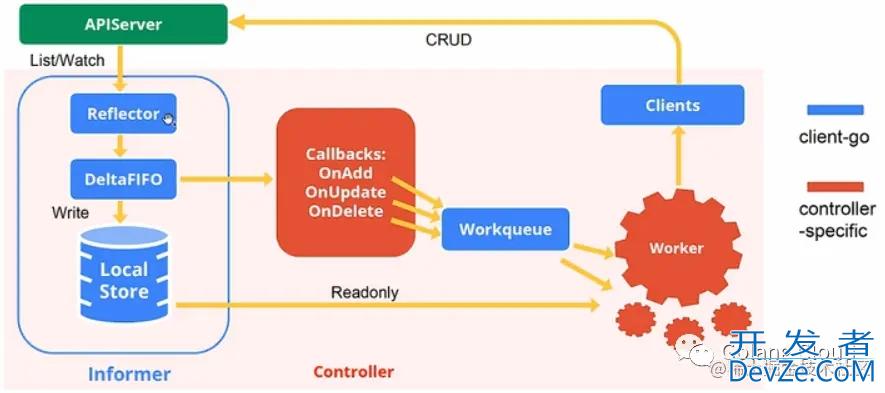go语言K8S 的 informer机制浅析
目录
- 正文
- 使用方法
- 创建Informer工厂
- 创建对象Informer结构体
- 注册事件方法
- 启动Informer
- 机制解析
- Reflector
- Controller
- Processer & Listener
- Indexer
- 总结
正文
Kubernetes的控制器模式是其非常重要的一个设计模式,整个Kubernetes定义的资源对象以及其状态都保存在etcd数据库中,通过apiserver对其进行增删查改,而各种各样的控制器需要从apiserver及时获取这些对象,然后将其应用到实际中,即将这些对象的实际状态调整为期望状态,让他们保持匹配。
不过这因为这样,各种控制器需要和apiserver进行频繁交互,需要能够及时获取对象状态的变化,而如果简单的通过暴力轮询的话,会给apiserver造成很大的压力,且效率很低,因此,Kubernetes设计了Informer这个机制,用来作为控制器跟apiserver交互的桥梁,它主要有两方面的作用:

依赖Etcd的List&Watch机制,在本地维护了一份目标对象的缓存。
Etcd的Watch机制能够使客户端及时获知这些对象的状态变化,然后通过List机制,更新本地缓存,这样就在客户端为这些API对象维护了一份和Etcd数据库中几乎一致的数据,然后控制器等客户端就可以直接访问缓存获取对象的信息,而不用去直接访问apiserver,这一方面显著提高了性能,另一方面则大大降低了对apiserver的访问压力;
依赖Etcd的Watch机制,触发控制器等客户端注册到Informer中的事件方法。
客户端可能会对某些对象的某些事件感兴趣,当这些事件发生时,希望能够执行某些操作,比如通过apiserver新建了一个pod,那么kube-scheduler中的控制器收到了这个事件,然后将这个pod加入到其队列中,等待进行调度。
Kubernetes的各个组件本身就内置了非常多的控制器,而自定义的控制器也需要通过Informer跟apiserver进行交互,因此,Informer在Kubernetes中应用非常广泛,本篇文章就重点分析下Informer的机制原理,以加深对其的理解。
使用方法
先来看看Informer是怎么用的,以Endpoint为例,来看下其使用Informer的相关代码:
创建Informer工厂
# client-go/informers/factory.go sharedInformers := informers.NewSharedInformerFactory(versionedClient, ResyncPeriod(s)())
首先创建了一个SharedInformerFactory,这个结构主要有两个作用:
- 一个是用来作为创建Informer的工厂,典型的工厂模式,在Kubernetes中这种设计模式也很常用;
- 一个是共享Informer,所谓共享,就是多个Controller可以共用同一个Informer,因为不同的Controller可能对同一种API对象感兴趣,这样相同的API对象,缓存就只有一份,通知机制也只有一套,大大提高了效率,减少了资源浪费。
创建对象Informer结构体
# client-go/informers/core/v1/endpoints.go
type EndpointsInformer interface {
Informer() cache.SharedIndexInformer
Lister() v1.EndpointsLister
}
endpointsInformer := kubeInformerFactory.Core().V1().Endpoints()
使用InformerFactory创建出对应版本的对象的Informer结构体,如Endpoints对象对应的就是EndpointsInformer结构体,该结构体实现了两个方法:Informer()和Lister()
- 前者用来构建出最终的Informer,即我们本篇文章的重点:SharedIndexInformer,
- 后者用来获取创建出来的Informer的缓存接口:Indexer,该接口可以用来查询缓存的数据,我准备下一篇文章单独介绍其底层如何实现缓存的。
注册事件方法
# Client-go/tools/cache/shared_informer.go
informer.AddEventHandler(cache.ResourceEventHandlerFuncs{
AddFunc: onAdd,
UpdateFunc: func(interface{}, interface{}) { fmt.Println("update not implemented") }, // 此处省略 workqueue 的使用
DeleteFuncjavascript: func(interface{}) { fmt.Println("delete not implemented") },
})
func onAdd(obj interface{}) {
node := obj.(*corev1.Endpoint)
fmt.Println("add a endpoint:", endpoint.Name)
}
这里,首先调用Infomer()创建出来SharedIndexInformer,然后向其中注册事件方法,这样当有对应的事件发生时,就会触发这里注册的方法去做相应的事情。其次调用Lister()获取到缓存接口,就可以通过它来查询Informer中缓存的数据了,而且Informer中缓存的数据,是可以有索引的,这样可以加快查询的速度。
启动Informer
# kubernetes/cmd/kube-controller-manager/app/controllermanager.go controllerContext.InformerFactory.Start(controllerContext.Stop)
这里InformerFactory的启动,会遍历Factory中创建的所有Informer,依次将其启动。
机制解析
Informer的实现都是在client-go这个库中,通过上述的工厂方法,其实最终创建出来的是一个叫做SharedIndexInformer的结构体:
# k8s.io/client-go/tools/cache/shared_informer.go
type sharedIndexInformer struct {
indexer Indexer
controller Controller
processor *sharedProcessor
cacheMutationDetector MutationDetector
listerWatcher ListerWatcher
......
}
func NewSharedIndexInformer(lw ListerWatcher, exampleObject runtphpime.Object, defaultEventHandlerResyncPeriod time.Duration, indexers Indexers) SharedIndexInformer {
realClock := &clock.RealClock{}
sharedIndexInformer := &sharedIndexInformer{
processor: &sharedProcessor{clock: realClock},
indexer: NewIndexer(DeletionHandlingMetaNamespaceKeyFunc, indexers),
listerWatcher: lw,
objectType: exampleObject,
resyncCheckPeriod: defaultEventHandlerResyncPeriod,
defaultEventHandlerResyncPeriod: defaultEventHandlerResyncPeriod,
cacheMutationDetector: NewCacheMutationDetector(fmt.Sprintf("%T", exampleObject)),
clock: realClock,
}
return sharedIndexInformer
}
可以看到,在创建SharedIndexInformer时,就创建出了processor, indexer等结构,而在Informer启动时,还创建出了controller, fifo queue, reflector等结构。
Reflector
Reflector的作用,就是通过List&Watch的方式,从apiserver获取到感兴趣的对象以及其状态,然后将其放到一个称为”Delta”的先进先出队列中。
所谓的Delta FIFO Queue,就是队列中的元素除了对象本身外,还有针对该对象的事件类型:
type Delta struct {
Type DeltaType
Object interface{}
}
目前有5种Type: Added, Updated, Deleted, Replaced, Resync,所以,针对同一个对象,可能有多个Delta元素在队列中,表示对该对象做了不同的操作,比如短时间内,多次对某一个对象进行了更新操作,那么就会有多个Updated类型的Delta放入到队列中。后续队列的消费者,可以根据这些Delta的类型,来回调注册到Informer中的事件方法。
而所谓的List&Watch,就是
- 先调用该API对象的List接口,获取到对象列表,将它们添加到队列中,Delta元素类型为Replaced,
- 然后再调用Watch接口,持续监听该API对象的状态变化事件,将这些事件按照不同的事件类型,组成对应的Delta类型,添加到队列中,Delta元素类型有Added, Updated, Deleted三种。
此外,Informer还会周期性的发送Resync类型的Delta元素到队列中,目的是为了周期性的触发注册到Informer中的事件方法UpdateFunc,保证对象的期望状态和实际状态一致,该周期是由一个叫做resyncPeriod的参数决定的,在向Informer中添加EventHandler时,可以指定该参数,若为0的话,则关闭该功能。需要注意的是,Resync类型的Delta元素中的对象,是通过Indexer从缓存中获取到的,而不是直接从apiserver中拿的,即这里resync的,其实是”缓存”的对象的期望状态和实际状态的一致性。
根据以上Reflector的机制,依赖Etcd的Watch机制,通过事件来获知对象变化状态,建立本地缓存。即使在Informer中,也没有周期性的调用对象的List接口,正常情况下,List&Watch只会执行一次,即先执行List把数据拉过来,放入队列中,后续就进入Watch阶段。
那什么时候才会再执行List呢?其实就是异常的时候,在List或者Watch的过程中,如果有异常,比如apiserver重启了,那么Reflector就开始周期性的执行List&Watch,直到再次正常进入Watch阶段。为了在异常时段,不给apiserver造成压力,这个周期是一个称为backoff的可变的时间间隔,默认是一个指数型的间隔,即越往后重试的间隔越长,到一定时间又会重置回一开始的频率。而且,为了让不同的apiserver能够均匀负载这些Watch请求,客户端会主动断开跟apiserver的连接,这个超时时间为60秒,然后重新发起Watch请求。此外,在控制器重启过程中,也会再次执行List,所以会观察到之前已经创建好的API对象,又重新触发了一遍AddFunc方法。
从以上这些点,可以编程客栈看出来,Kubernetes在性能和稳定性的提升上,还是下了很多功夫的。
Controller
这里Controller的作用是通过轮询不断从队列中取出Delta元素,根据元素的类型,一方面通过Indexer更新本地的缓存,一方面调用Processor来触发注册到Informer的事件方法:
# k8s.io/client-go/tools/cache/controller.go
func (c *controller) processLoop() {
for {
obj, err := c.config.Queue.Pop(PopProcessFunc(c.config.Process))
}
}
这里的c.config.Process是定义在shared_informer.go中的HandleDeltas()方法:
# k8s.io/client-go/tools/cache/shared_informer.go
func (s *sharedIndexInformer) HandleDeltas(obj interface{}) error {
s.blockDeltas.Lock()
defer s.blockDeltas.Unlock()
// from oldest to newest
for _, d := range obj.(Deltas) {
switch d.Type {
case Sync, Replaced, Added, Updated:
s.cacheMutationDetector.AddObject(d.Object)
if old, exists, err := s.indexer.Get(d.Object); err == nil && exists {
if err := s.indexer.Update(d.Object); err != nil {
return err
}
isSync := false
switch {
case d.Type == Sync:
// Sync events are only propagated to listeners that requested resync
isSync = true
case d.Type == Replaced:
if Accessor, err := meta.Accessor(d.Object); err == nil {
if oldAccessor, err := meta.Accessor(old); err == nil {
// Replaced events that didn't change resourceVersion are treated as resync events
// and only propagated to listeners that requested resync
isSync = accessor.GetResourceVersion() == oldAccessor.GetResourceVersion()
}
}
}
s.processor.distribute(updateNotification{oldObj: old, newObj: d.Object}, isSync)
} else {
if err := s.indexer.Add(d.Object); err != nil {
return err
}
s.processor.distribute(addNotification{newObj: d.Object}, false)
}
case Deleted:
if err := s.indexer.Delete(d.Object); err != nil {
return err
}
s.processor.distribute(deleteNotification{oldObj: d.Object}, false)
}
}
return nil
}
Processer & Listener
Processer和Listener则是触发事件方法的机制,在创建Informer时,会创建一个Processer,而在向Informer中通过调用AddEventHandler()注册事件方法时,会为每一个Handler生成一个Listener,然后将该Lisener中添加到Processer中,每一个Listener中有两个channel:addCh和nextCh。Listener通过select监听在这两个channel上,当Controller从队列中取出新的元素时,会调用processer来给它的listener发送“通知”,这个“通知”就是向addCh中添加一个元素,即add(),然后一个goroutine就会将这个元素从addCh转移到nextCh,即pop(),从而触发另一个goroutine执行注册的事件方法,即run()。
# k8s.io/client-go/tools/cache/shared_informer.go
func (p *shared编程客栈Processor) distribute(obj interface{}, sync bool) {
p.listenersLock.RLock()
defer p.listenersLock.RUnlock()
if sync {
for _, listener := range p.syncingListeners {
listener.add(obj)
}
} else {
for _, listener := range p.listeners {
listener.add(obj)
}
}
}
func (p *processorListener) add(notification interface{}) {
p.addCh <- notification
}
func (p *processorListener) pop() {
defer utilruntime.HandleCrash()
defer close(p.nextCh) // Tell .run() to stop
var nextCh chan<- interface{}
var notification interface{}
for {
select {
case nextCh <- notification:
// Notification dispatched
var ok bool
notification, ok = p.pendingNotifications.ReadOne()
if !ok { // Nothing to pop
nextCh = nil // Disable this select case
}
case notificationToAdd, ok := <-p.addCh:
if !ok {
return
}
if notification == nil { // No notification to pop (and pendingNotifications is empty)
// Optimize the case - skip adding to pendingNotifications
notification = notificationToAdd
nextCh = p.nextCh
} else { // There is already a notification waiting to be dispatched
p.pendingNotifications.WriteOne(notificationToAdd)
}
}
}
}
func (p *processorListener) run() {
// this call blocks until the channel is closed. When a panic happens during the notification
// we will catch it, **the offending item will be skipped!**, and after a short delay (one second)
// the next notification will be attempted. This is usually better than the alternative of never
// delivering again.
stopCh := make(chan struct{})
wait.Until(func() {
for next := range p.nextCh {
switch notification := next.(type) {
case updateNotification:
p.handler.OnUpdate(notification.oldObj, notification.newObj)
case addNotification:
p.handler.OnAdd(notification.newObj)
case deleteNotification:
p.handler.OnDelete(notification.oldObj)
default:
utilruntime.HandleError(fmt.Errorf("unrecognized notification: %T", next))
}
}
// the androidonly way to get here is if the p.nextCh is empty and closed
close(stopCh)
}, 1*time.Second, stopCh)
}
Indexer
Indexer是对缓存进行增删查改的接口,缓存本质上就是用map构建的key:value键值对,都存在items这个map中,key为/:
type threadSafeMap struct {
lock sync.RWMutex
items map[string]interface{}
// indexers maps a name to an IndexFunc
indexers Indexers
// indices maps a name to an Index
indices Indices
}
而为了加速查询,还可以选择性的给这些缓存添加索引,索引存储在indecies中,所谓索引,就是在向缓存中添加记录时,就将其key添加到索引结构中,在查找时,可以根据索引条件,快速查找到指定的key记录,比如默认有个索引是按照namespace进行索引,可以根据快速找出属于某个namespace的某种对象,而不用去遍历所有的缓存。
Indexer对外提供了Replace(), Resync(), Add(), Update(), Delete(), List(), Get(), GetByKey(), ByIndex()等接口。
总结
本篇对Kubernetes Informer的使用方法和实现原理,进行了深入分析,整体上看,Infor开发者_开发入门mer的设计是相当不错的,基于事件机制,一方面构建本地缓存,一方面触发事件方法,使得控制器能够快速响应和快速获取数据,此外,还有诸如共享Informer, resync, index, watch timeout等机制,使得Informer更加高效和稳定,有了Informer,控制器模式可以说是如虎添翼。
以上就是go语言K8S 的 informer机制浅析的详细内容,更多关于go K8S informer机制浅析的资料请关注我们其它相关文章!





 加载中,请稍侯......
加载中,请稍侯......
精彩评论